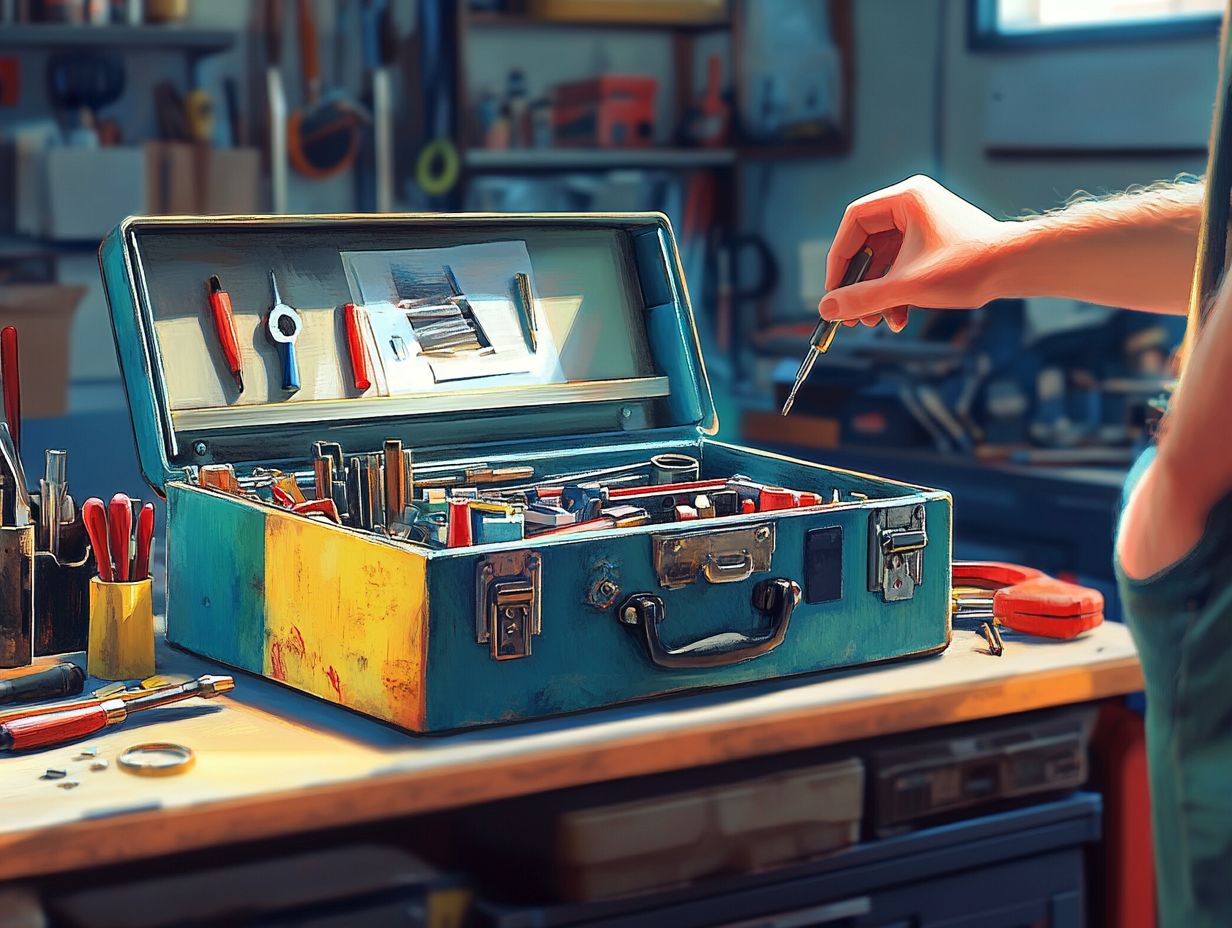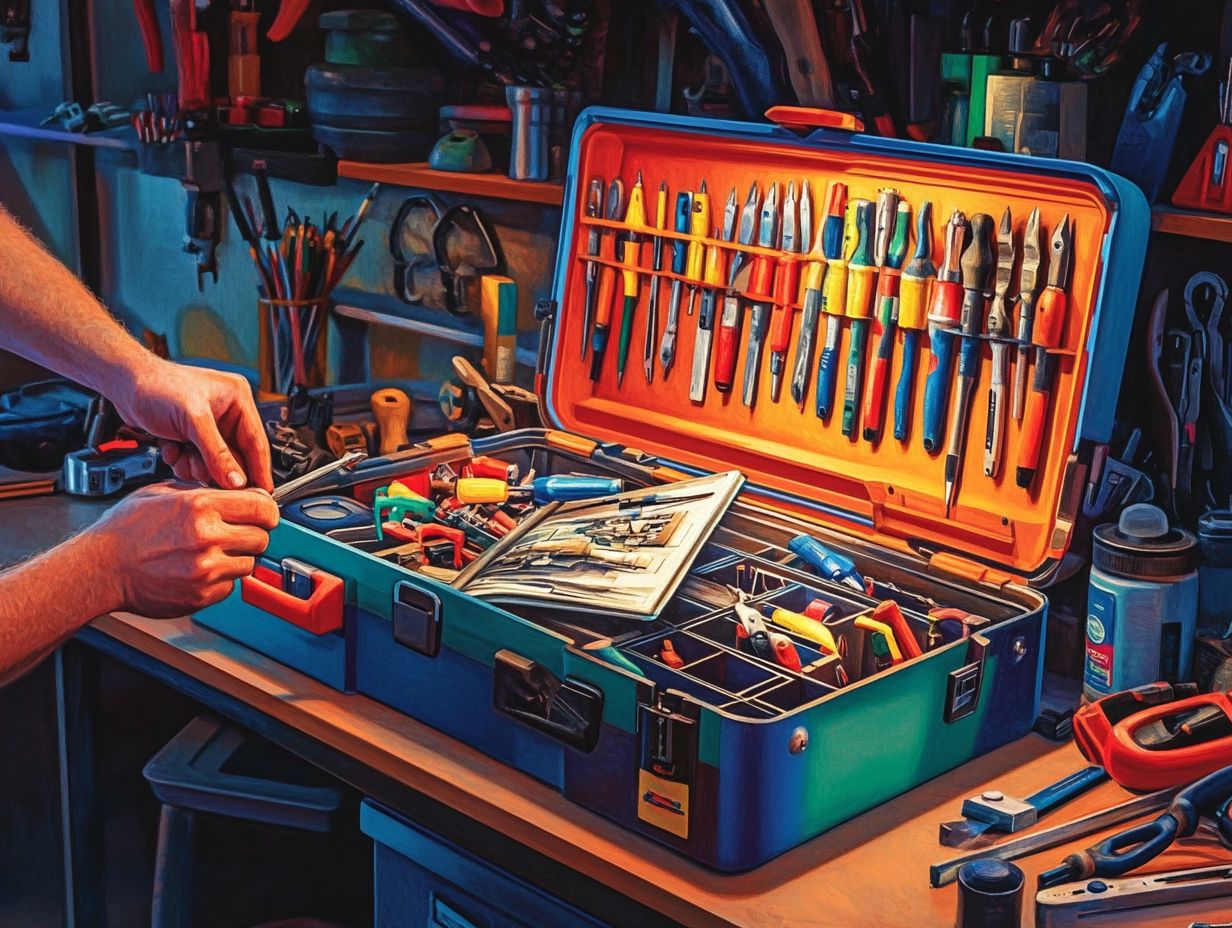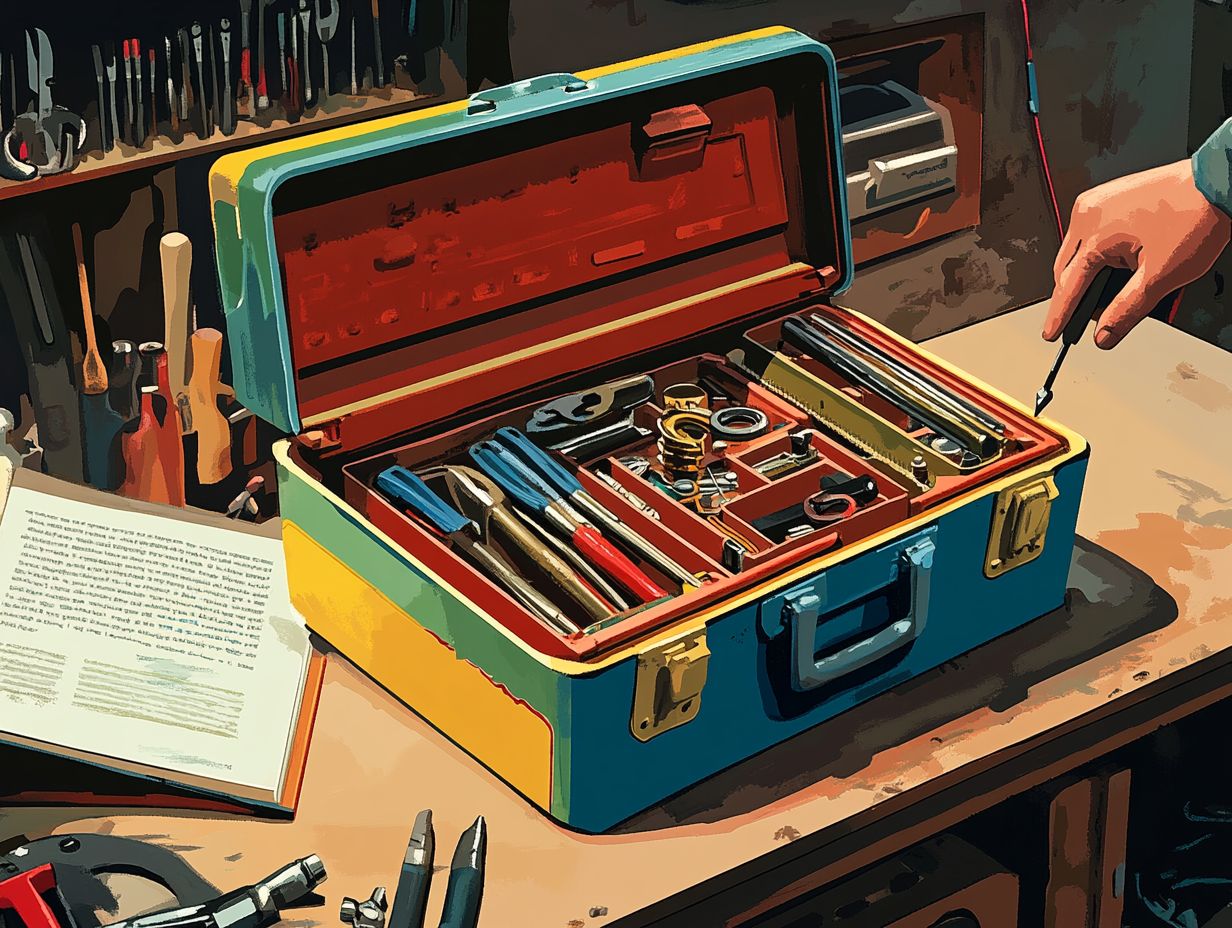How to Choose the Right Parts for Common Repairs
When addressing repairs, selecting the right parts is crucial.
Whether you’re fixing a vehicle, a home appliance, or any other equipment, knowing how to identify issues, research compatible components, and evaluate quality, cost, and installation can save you both time and money.
Let s dive into how to make successful repairs, from diagnosing problems to ensuring proper maintenance, empowering you to make informed decisions.
Contents
- Key Takeaways:
- Understanding the Importance of Choosing the Right Parts
- Identifying the Problem
- Researching the Part
- Factors to Consider When Choosing Parts
- Where to Purchase Parts
- Ensuring Proper Installation
- Maintenance and Care for New Parts
- Frequently Asked Questions
- How do I choose the right parts for common repairs?
- Can I use generic parts for common repairs?
- Should I buy new or used parts for common repairs?
- Are there any red flags to look out for when choosing parts for common repairs?
- Do I need any special tools to install the chosen parts for common repairs?
- What should I do if the chosen part doesn’t fit or work as expected?
Key Takeaways:

- Choose the right parts for common repairs to ensure proper functionality and prolong the lifespan of your appliances or machinery.
- Thoroughly diagnose the issue to determine the specific part needed for replacement.
- Consider quality, compatibility, and cost when researching and purchasing parts, whether online or in-store.
Understanding the Importance of Choosing the Right Parts
Selecting the right parts such as Original Equipment Manufacturer (OEM) parts, aftermarket options, or repair kits can greatly impact your vehicle s longevity and performance.
For both DIY enthusiasts and seasoned mechanics, understanding the importance of selecting the right replacement parts is essential for achieving service efficiency, optimal performance, and compliance with engineering standards.
Poor choices can lead to maintenance headaches, rising costs, and safety hazards, highlighting the need to turn to reputable brands and manufacturers.
Stay informed about market options and the latest vehicle manuals to boost your confidence when selecting parts.
Identifying the Problem
Identifying the issue with your vehicle is the first essential step in securing optimal performance and safety. This is particularly critical when addressing brake systems or hydraulic systems that may show noise problems or caliper sticking.
Taking time to pinpoint these concerns ensures you maintain both functionality and safety.
Diagnosing the Issue
Diagnosing the issue requires a systematic approach, starting with a thorough examination of your vehicle’s manuals and common maintenance problems specific to components, like noisy brake systems.
After that, conduct a careful assessment of your vehicle s overall condition. Pay attention to any noticeable symptoms; strange sounds or warning lights can provide invaluable clues about potential issues.
Gathering the right diagnostic tools is crucial for an in-depth analysis. You may need specialized equipment to check everything from engine performance to electrical components.
If diagnostics reveal a complex issue, consulting professional repair resources can clarify potential fixes, ensuring your vehicle remains safe and reliable on the road. Remember to keep documentation of your observations throughout this process to help track any recurring issues.
Researching the Part
Researching the right part is essential for ensuring it fits seamlessly and performs well in your vehicle. This often requires navigating a variety of options, from OEM parts to third-party vendors.
Understanding the quality of available repair kits and replacement parts will enable you to make informed decisions that enhance your vehicle’s performance and longevity.
Finding Compatible Parts

Finding compatible parts for your vehicle requires a keen alignment with your specific needs. Ensuring that the replacement components enhance both performance and longevity is essential.
To navigate this landscape effectively, refer to the detailed specifications found in your owner s manual or the manufacturer s guidelines. These documents often contain vital information regarding sizes, materials, and the standards that need to be met.
Utilizing fitment guides can significantly simplify this process, enabling you to quickly compare potential parts against established data tailored to your make and model.
Consider whether to choose aftermarket or OEM options, as each has its own advantages and disadvantages. Aftermarket parts are made by companies other than the original manufacturer, while OEM stands for Original Equipment Manufacturer, referring to parts made by the vehicle’s manufacturer.
While OEM parts typically guarantee a precise fit and original quality, aftermarket alternatives can offer more budget-friendly choices, sometimes even delivering enhanced performance features. By carefully weighing these factors, you can ensure that the components you select not only fit seamlessly but also perform optimally over time.
Factors to Consider When Choosing Parts
When selecting the right parts for your vehicle, several crucial factors demand your attention. You ll need to consider the quality of each component, conduct a thoughtful cost comparison among various vendors, and evaluate brand reliability. All of these can profoundly impact your vehicle’s performance and longevity.
Quality, Compatibility, and Cost
The interplay of quality, compatibility, and cost is crucial when making decisions about auto parts. You must balance the allure of trusted brands with your budget constraints, ensuring compatibility with your existing components.
Navigating this landscape involves recognizing that not all inexpensive parts offer long-term value. Lower quality can lead to performance issues or even breakdowns, resulting in further repairs that ultimately drive up your costs.
Conversely, choosing established brands like Bosch or Denso can guarantee that the components integrate seamlessly with your vehicle’s systems, significantly boosting reliability.
These brands invest heavily in research and development, adhering to strict quality standards that ensure their products not only meet but exceed the demands of modern vehicles. While the initial investment may be higher, the assurance of durability and fit provides invaluable peace of mind.
Where to Purchase Parts
Choosing where to buy auto parts is a crucial decision in your repair journey. You have a variety of options at your disposal, from local auto parts stores to online vendors and parts distributors.
Each choice comes with its own level of consumer trust and varying warranty claim options. It s essential to weigh these factors carefully to ensure a smooth experience.
Online vs. In-Store Options
When you re weighing the options between online vendors and local auto parts stores, consider factors such as consumer trust, the availability of warranty claims, and the range of choices each option offers.
You might find yourself caught between the immediate gratification of picking up items at local stores and the often lower prices that online platforms provide.
While the convenience of quickly purchasing and physically examining parts at brick-and-mortar locations is appealing, the cost savings of online shopping can be hard to resist.
However, with the risks that come from buying from unfamiliar online vendors, researching reviews and ratings to verify reliability becomes essential. Consumer experiences can vary widely, so doing your homework is crucial.
Striking the right balance among these trade-offs will enable you to make a well-informed decision.
Ensuring Proper Installation

Ensuring the proper installation of auto parts is essential for achieving optimal vehicle performance and longevity. This process demands careful attention to assembly lubrication and the correct utilization of brake hardware kits, among other important repair solutions.
Tips for Installing Parts Correctly
When you re installing parts, using repair kits effectively, ensuring proper assembly lubrication, and including fasteners and o-rings can elevate the safety and performance of your brake systems.
By closely following the manufacturer’s guidelines, you can avoid common pitfalls that might undermine functionality. Be sure to choose the recommended tools for each specific component to ensure a precise fit and secure attachment.
Inspecting related parts, such as rotors and calipers, during installation will provide a clearer picture of the overall system health. This enables you to make informed decisions about parts replacement and additional maintenance.
These practices enhance your vehicle s reliability and contribute to a smoother, more enjoyable driving experience.
Maintenance and Care for New Parts
Proper maintenance and care for new parts are crucial for extending their lifespan and ensuring they perform as intended. This is especially true for components like hydraulic seals (which prevent fluid leaks) and systems that require regular pump maintenance.
Focusing on regular care can maximize the efficiency and reliability of your machinery.
Extending the Lifespan of Parts
To extend the lifespan of your auto parts, take a proactive approach to maintenance and invest in quality repair solutions that meet current environmental standards.
Regularly checking components such as brake pads, filters, and fluids will help you catch early wear before it becomes a bigger issue. Opting for high-quality replacements that adhere to stringent environmental guidelines improves performance and reduces waste and pollution.
Being aware of how certain parts interact with factors like humidity and temperature can significantly enhance their longevity. Implementing routine inspections and proper storage practices can mitigate potential damage from environmental elements, ensuring your vehicle remains functional for the long haul.
Watch this video for more tips on maintaining your auto parts.
Frequently Asked Questions
How do I choose the right parts for common repairs?

Choosing the right parts for common repairs can be daunting, but getting it right is essential for a successful, long-lasting repair. Here are some tips to help you make the right choice:
- Identify the specific part you need: Make sure you know exactly what part you need to save time and effort.
- Check compatibility: Ensure the part is compatible with your specific make and model for a perfect fit and functionality.
- Compare prices: Don t settle for the first option. Compare prices from different suppliers to find the best deal.
- Read reviews: Look for reviews from other customers to gauge the quality and reliability of the part.
- Consider warranties: Some parts come with warranties, providing peace of mind in case of issues.
- Consult a professional: If you re unsure, consult a professional for their expertise and guidance.
Can I use generic parts for common repairs?
Generic parts can be cost-effective for common repairs. However, ensure they are compatible and of good quality before purchasing. Consulting a professional for their opinion on using generic parts is always a wise choice.
Should I buy new or used parts for common repairs?
This ultimately depends on your budget and the specific part you need. Used parts can be more affordable, but they may not last as long as new parts. Consider your options carefully and ensure the used part is in good condition before purchasing.
Are there any red flags to look out for when choosing parts for common repairs?
Yes, there are a few red flags to watch out for. Look for very cheap prices, unclear compatibility information, and negative reviews.
If something seems too good to be true, it probably is!
Do I need any special tools to install the chosen parts for common repairs?
It depends on the repair and the part. Some may require special tools, so check what you need first.
What should I do if the chosen part doesn’t fit or work as expected?
If the part doesn’t fit or work, contact the supplier or manufacturer for help. They can assist with a replacement or refund.
Consult a professional for their advice as well!






